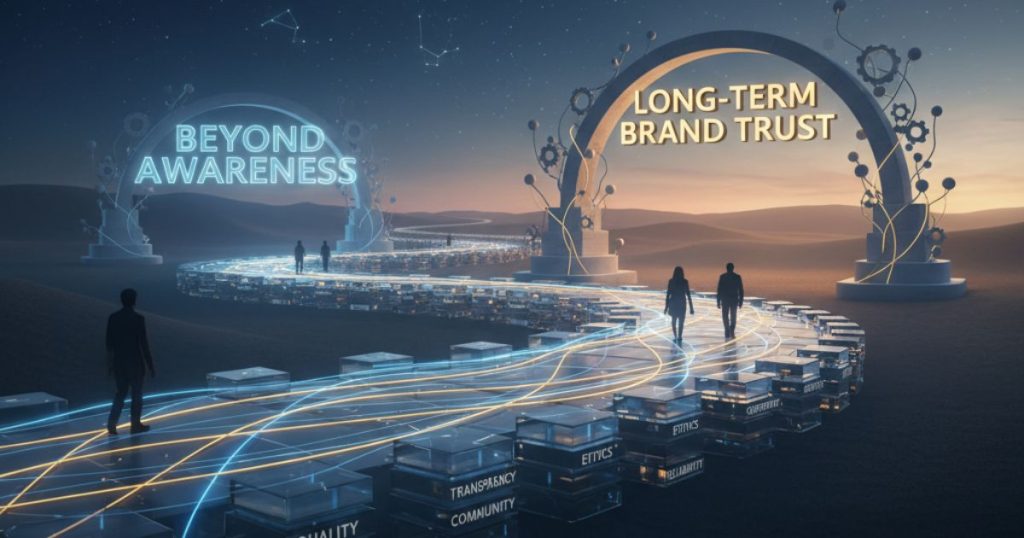Beyond Awareness: Building Long-Term Brand Trust

Brand awareness is a common goal for marketers, but what happens after someone knows your name? Getting noticed is just the first step. The real challenge—and the key to sustainable success—is building genuine, long-term brand trust. When customers trust your brand, they don’t just buy from you once; they become loyal advocates who remain committed to you through thick and thin.
This post will guide you through the essential strategies for moving beyond simple recognition to create a brand that earns and keeps consumer trust. We’ll explore actionable steps for building brand credibility and fostering a loyal customer base. By the end, you’ll have a clear roadmap for a long-term branding strategy that drives lasting growth.
What is Brand Trust?
Brand trust is the confidence consumers have in your company’s ability to deliver on its promises. It’s the belief that your brand is reliable, honest, and has its customers’ best interests at heart. This trust isn’t built overnight. It’s earned through consistent positive experiences, transparent communication, and a clear commitment to your values.
Think of it like any other relationship. Trust is built on a series of small, positive interactions over time. A single misstep can damage it, and rebuilding can be a slow and difficult process. That’s why a proactive approach to brand trust building is so important.
Why Building Brand Trust is Non-Negotiable

In a crowded marketplace, consumer trust is your most valuable asset. It’s the foundation of customer loyalty and the ultimate driver of long-term profitability. Here’s why it’s so critical for your business:
- It Fosters Loyalty: Trust is the glue that holds customer relationships together. A study by Edelman found that 81% of consumers stated they need to be able to trust the brand before buying from it. Loyal customers are more likely to make repeat purchases and are less sensitive to price changes.
- It Boosts Credibility: A trustworthy brand is seen as an expert in its field. This brand credibility makes it easier to launch new products, enter new markets, and attract top talent.
- It Drives Word-of-Mouth Marketing: Happy, trusting customers become your best marketers. They’ll recommend your brand to friends and family, creating a powerful and cost-effective marketing channel.
- It provides a Competitive Edge: When customers trust you, they’re less likely to switch to a competitor, even if offered a lower price. This resilience is a significant competitive advantage.
How to Build a Brand That People Trust
Building brand trust requires a deliberate and consistent effort across your entire organization. It’s not just a marketing task; it’s a company-wide commitment. Here are five key strategies for your long-term branding strategy.
1. Be Transparent and Authentic
Brand authenticity is about being true to who you are as a company. Don’t try to be something you’re not. Consumers can spot a fake from a mile away. Transparency means being open and honest in all your communications, especially when things go wrong.
- Admit Mistakes: If you make an error, own it. Apologize sincerely and explain what you’re doing to rectify the situation. This shows humility and a commitment to your customers.
- Share Your Values: Clearly communicate what your brand stands for. Patagonia, for example, has built incredible trust by being transparent about its environmental mission and supply chain practices.
- Avoid Hidden Fees and Fine Print: Be upfront about pricing and policies. Unexpected charges are a quick way to destroy trust.
2. Deliver Consistent, High-Quality Experiences
Consistency is the cornerstone of reliability. Every interaction a customer has with your brand—from your website to customer service to the product itself—should be consistently positive and of high quality.
- Maintain Brand Consistency: Ensure your branding (logo, messaging, tone of voice) is consistent across all channels. This builds recognition and a sense of stability.
- Provide Excellent Customer Service: Every customer service interaction is an opportunity to build or break trust. Train your team to be helpful, empathetic, and efficient.
- Ensure Product Quality: Your product or service must consistently deliver on its promises. A reliable product is the most fundamental aspect of building brand trust.
3. Encourage and Act on Customer Feedback
Listening to your customers shows that you value their opinions and are committed to meeting their needs. Actively seek out feedback and, more importantly, act on it.
- Make it Easy to Give Feedback: Use surveys, reviews, and social media to gather customer opinions.
- Respond to Reviews (Both Good and Bad): Thank customers for positive reviews and address concerns in negative ones. A thoughtful response to criticism can often win back a disgruntled customer.
- Use Feedback for Improvement: Don’t just collect feedback—use it to make meaningful improvements to your products and services. Let your customers know how their input has led to change.
4. Showcase Social Proof
People trust other people more than they trust brands. Social proof, like customer reviews, testimonials, and case studies, provides third-party validation that your brand is trustworthy.
- Display Customer Reviews Prominently: Feature reviews on your product pages and website.
- Share User-Generated Content: Encourage customers to share photos and videos of themselves using your products. This is a powerful form of authentic marketing.
- Highlight Testimonials and Case Studies: Detailed stories of how your product has helped real customers can be incredibly persuasive in building brand credibility.
5. Engage in Loyalty Marketing
Loyalty marketing is about rewarding your existing customers for their continued business. A good loyalty program demonstrates appreciation and provides customers with a reason to continue coming back.
- Offer Exclusive Perks: Provide loyal customers with special discounts, early access to new products, or exclusive content.
- Create a Community: Build a space where your customers can connect with each other and your brand. This could be a Facebook group, a forum, or exclusive events.
- Personalize the Experience: Use customer data to tailor offers and communications. A personalized experience shows that you understand and value the individual customer.
From Recognition to Lasting Relationships

Moving beyond brand awareness to build genuine, long-term trust is the ultimate goal of any successful business. It requires a deep commitment to transparency, consistency, and a customer-centric approach. By focusing on brand authenticity and delivering exceptional experiences, you can transform first-time buyers into lifelong fans, creating a truly resonant brand that connects deeply with your audience.
Start today by evaluating your current practices. Where can you be more transparent? How can you improve consistency? By making brand trust building a central part of your strategy, you’ll be investing in the most valuable asset your company can have: a loyal and trusting customer base.
Frequently Asked Questions (FAQs)
How long does it take to build brand trust?
Building brand trust is a long-term process. It doesn’t happen overnight. It requires consistent effort and a commitment to your customers over the course of months and years. While you can see positive signs early on, deep, lasting trust is the result of a sustained long-term branding strategy.
Can a single negative event destroy brand trust?
A single negative event can certainly damage brand trust, but it doesn’t have to destroy it. How a brand responds is crucial. If the company is transparent, takes responsibility, and makes things right, it can often strengthen trust in the long run.
What is the difference between brand awareness and brand trust?
Brand awareness is simply whether consumers have heard of your brand. Brand trust is the confidence consumers have in your brand’s promises and integrity. Awareness is the first step, but trust is what leads to loyalty and long-term success.






